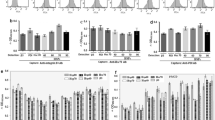Summary
Entry of the KUN strain of human rotavirus into MA 104 cells was studied by electron microscopy. Double-shelled rotavirus particles attached to the cell membrane, and in the presence of trypsin their nucleic acids were expelled from the virus core into the cytoplasm through radial spaces between the capsomeres and the cell membrane pores formed after their attachment. This mechanism was considered to be analogous to those of phages.
Similar content being viewed by others
References
Aoyagi T, Nerome T, Suzuki J, Takeuchi T, Umezawa H (1974) Change of enzyme activities during the early stage of influenza virus infection. Biochem Biophys Res Com 60: 1178–1184
Bartlett NM, Gillies SC, Bullivant S, Bellamy AR (1974) Electron microscopy study of reovirus reaction cores. J Virol 14: 315–326
Bican P, Cohen J, Charpelienne A, Scherrer R (1982) Purification and characterization of bovine rotavirus cores. J Virol 43: 1113–1117
Borsa J, Sargent MD, Lievaart PA, Copps TP (1981) Reovirus: evidence for a second step in the intracellular uncoating and transcriptase activation process. Virology 111: 191–200
Clark SM, Roth JR, Clark ML, Barnett BB, Spendlove RS (1981) Trypsin enhancement of rotavirus infectivity: mechanism of enhancement. J Virol 39: 816–822
Cohen J (1977) Ribonucleic acid polymerase activity associated with purified calf rotavirus. J gen Virol 36: 395–402
Cohen J, Laporte J, Charpillienne A, Scherrer R (1979) Activation of rotavirus RNA polymerase by calcium chelation. Arch Virol 60: 177–186
Espejo RT, Lopez S, Arias C (1981) Structural polypeptides of simian rotavirus SA 11 and the effect of trypsin. J Virol 37: 165–170
Estes MK, Graham DY, Mason BB (1981) Proteolytic enhancement of rotavirus infectivity: Molecular mechanism. J Virol 39: 979–888
Homma M, Ouchi M (1973) Trypsin action on the growth in eggs and tissue culture cells. J Virol 12: 1457–1465
Kutsuzawa T, Konno T, Suzuki H, Kapikian AZ, Ebina T, Ishida N (1982) Isolation human rotavirus subgroup 1 and 2 in cell cultures. J Clin Microbiol 16: 727–730
Sargent MD, Long DS, Borsa J (1977) Functional analysis of the interactions between reovirus particles and various proteasesin vitro. Virology 78: 354–358
Simon L, Anderson TF (1967) The infection of Escherichia coli by T 2 and T 4 bacteriophages as seen in the electron microscope. I. Attachment and penetration. Virology 32: 279–310
Simon L (1969) The infection of Escherichia coli by T 2 and T 4 bacteriophages as seen in the electron microscope. III. Membrane-associated intracellular bacteriophages. Virology 38: 285–296
Suzuki H, Kitaoka S, Konno T, Sato T, Ishida N (1985) Two modes of human rotavirus entry into MA 104 cells. Arch Virol 85: 25–43
Yazaki K, Miura K (1982) Relation of the structure of cytoplasmic polyhedrosis virus and the synthesis of its messenger RNA. Virology 123: 93–101
Author information
Authors and Affiliations
Additional information
With 7 Figures
Rights and permissions
About this article
Cite this article
Suzuki, H., Kitaoka, S., Sato, T. et al. Further investigation on the mode of entry of human rotavirus into cells. Archives of Virology 91, 135–144 (1986). https://doi.org/10.1007/BF01316734
Received:
Accepted:
Issue Date:
DOI: https://doi.org/10.1007/BF01316734




